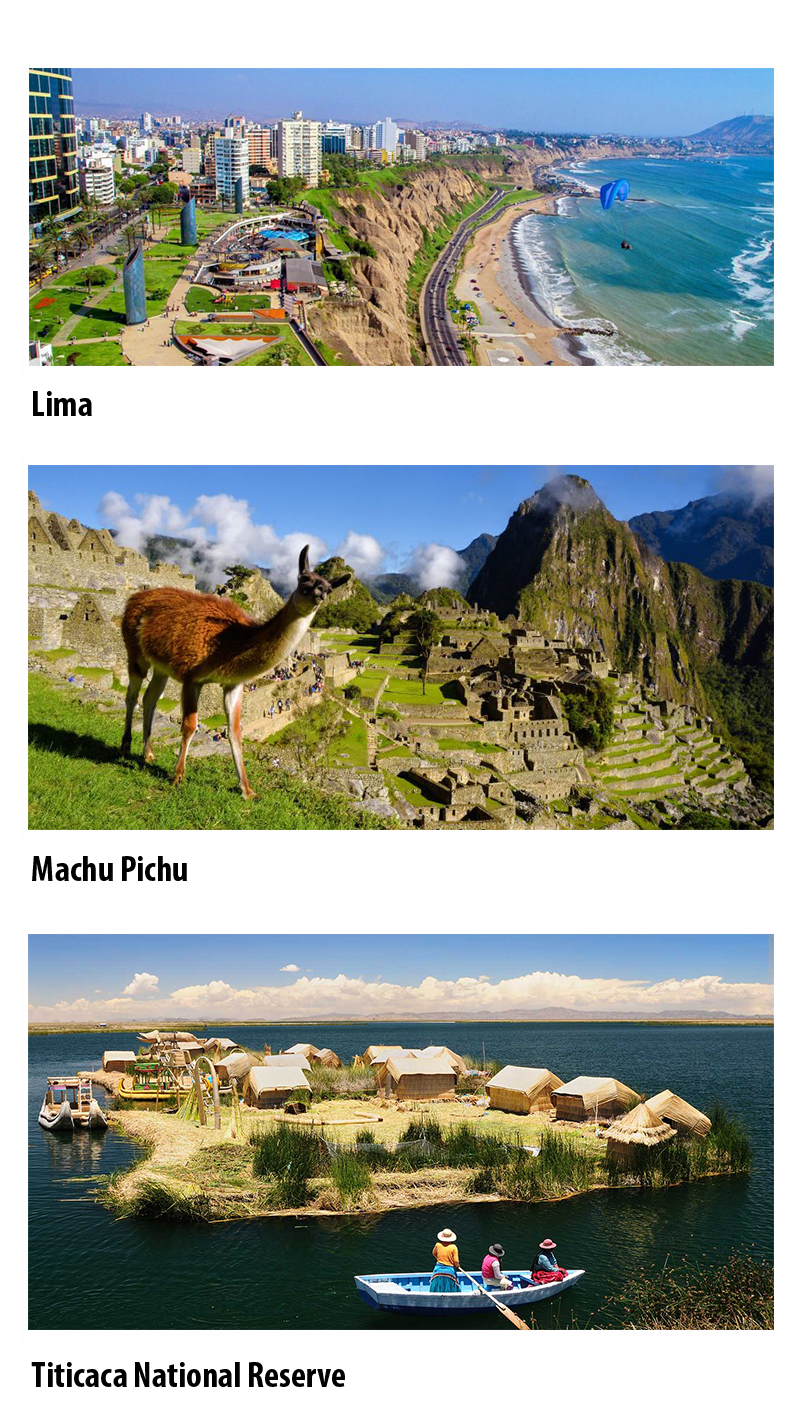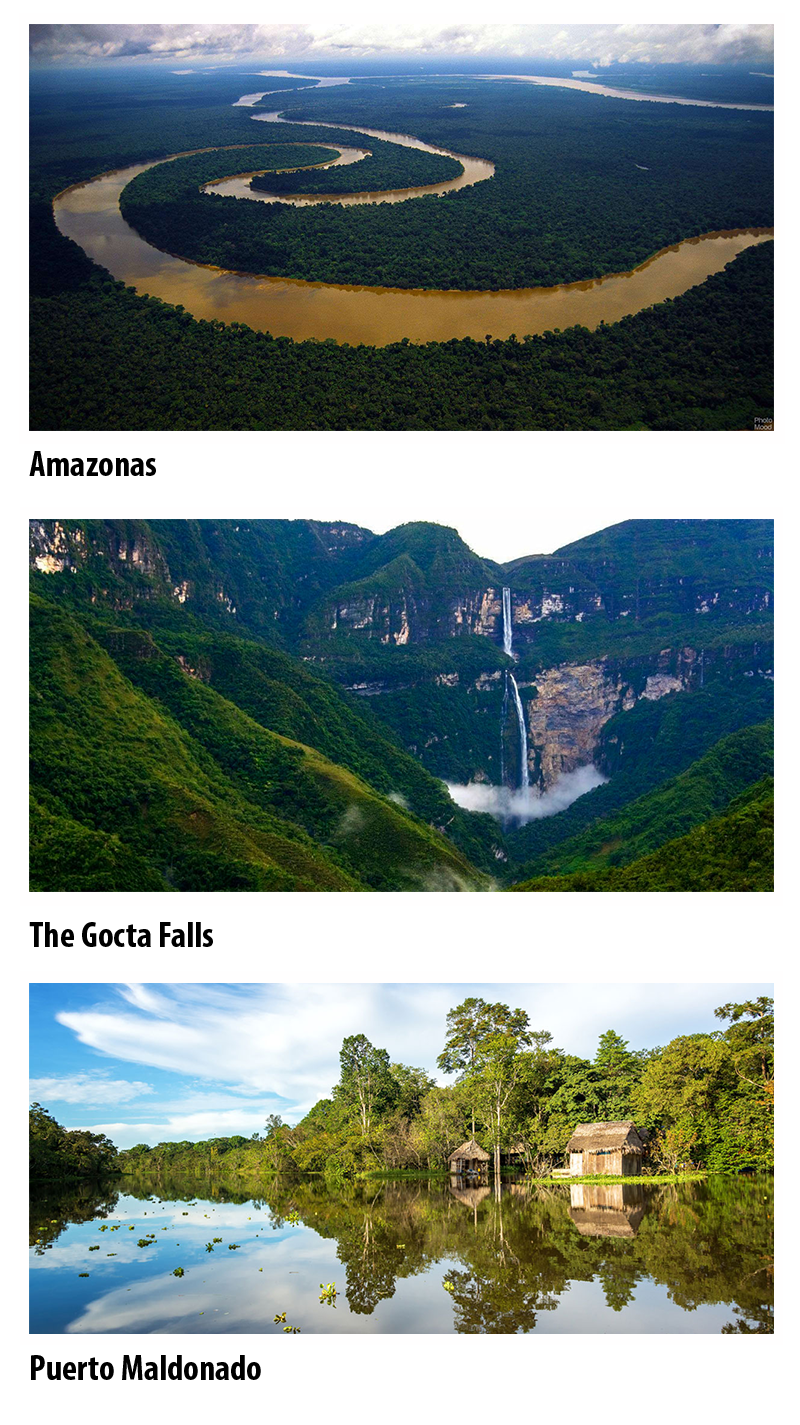Peru is located in the western and central part of South America. Its territory borders Ecuador and Colombia to the north, Brazil and Bolivia to the east, and Chile to the south; covering an area of 496,224 square miles. Additionally, the Peruvian maritime domain covers as many as 200 nautical miles in the Pacific Ocean.
Peru is an extremely diverse country, with 11 ecological regions and 84 of the worlds 117 different types of life zone. It has a huge variety of scenery thanks to its geography, which also provides it with a wide range of natural resources. The country has 3 main regions according to the traditional method of dividing the country by altitude: coast, mountains and jungle.
Coast:
Characterized by a narrow band of deserts and fertile valleys alongside the Pacific Ocean. The fertile valleys spring from the rivers that flow down from the Andes mountain range itself, as opposed to the lower-lying sierra, and into the sea. The coast has a warm-temperate climate, without extreme heat or cold but with high humidity and dense fog that makes it feel extremely cold in winter. In the summer there is very little fog and temperatures reach 30C. In the north, the coast is hot almost all year round, with a short rainy period in November and December. The central and southern coast has two distinct seasons, winter (April to October) and summer (November to March).
Highlands:
This is the mountainous region of Peru, where the Andes mountain range dominates the landscape and contains various ecological regions and altitudes. The northern Andes are lower and more humid than the rest, while the central Andes are the tallest and steepest, and it is here where you find the countrys highest peak, Huascaran, at 6,768 meters above sea level. The southern Andes are wider, and are also known as the altiplano, or high Andean plateau. The sierra has two seasons: summer (April to October) with sunny days, cold nights and little rain - this is the perfect time to visit; and winter (November to March), when it rains heavily. During the day, temperatures can reach 24C, and at night they can fall to -3C.
Jungle:
Located in the east, this is a vast region of plains covered by vegetation in the Amazon River basin, which begins at the confluence of the Maranon and Ucayali rivers. It is Perus largest region, and consists of highland jungle, or the mountains eyebrows, (over 700 meters above sea level), which is characterized by its cloud forests, and lowland jungle (less than 700 meters above sea level). Like the sierra, the jungle has two distinct seasons. From November to March it rains frequently, while from April to October it is fairly dry, making this the ideal time to visit as the rivers subside and the roads are easily accessible. There is high humidity all year round. Occasionally, between May and August, there are friajes or surazos, cold snaps caused by winds from the extreme south of the continent, during which the temperature can fall to between 8 and 12C. Information about the weather of the countrys different regions can be found here.

info@andescampers.com

'Lima is Peru', as the celebrated Peruvian writer Abraham Valdelomar quite rightly said. You can encounter all our races and customs in its colonial streets and modern districts that look out onto the Pacific Ocean, a synthesis of our cultural diversity and our incomparable gastronomy, as well as certain manifestations that allow us to understand the complex history of our country a little better.
But beyond this historical-cultural aspect of Peru capital, Lima is also film and theater, good music, shopping and art galleries, nights out, museums and a different cityscape that looks out onto the sea, and in which the present and the past combine to create a city like few in the world.
Handicrafts, alpaca, jewelry, silverware, painting, photography, Lima is the best place to go shopping and it has an interesting range of shopping centers, art galleries, workshops and craft shops and ateliers where you can buy the best Peruvian products from every region.
Its range of restaurants, bars and markets has made it recognized as the gastronomic capital of the region. The city houses three of the 50 best restaurants in the world and nine of the 50 best in Latin America, according to the 2016 list compiled by Restaurant magazine. But it also has an important pre-Hispanic legacy, with archaeological sites in the middle of the city, such as the huacas of Mateo Salado, Pucllana or Huallamarca, and sanctuaries such as Pachacamac, located on the southern outskirts of the city.
The Historic Sanctuary of Machu Picchu, a Unesco World Cultural and Natural Heritage site, is one of the most important attractions in the country, but it is also among the places with the greatest biodiversity. In addition, this extraordinary place allows a certain number of visitors per day to enter in two shifts so that they can obtain an exclusive view of the impressive perfection of its imperial architecture.
There are many tourists who choose this location in the region of Puno due to the numerous cultural manifestations of its native peoples, some of whom live on floating islands. This natural area, located between Peru and Bolivia, is home to aquatic birds, animals and endemic plants. Lake Titicaca is 280 meters deep, houses 36 islands, connects Peru with Bolivia and can be crossed aboard magnificent boats.
Among the dunes of Ica there are red sand beaches where you can enjoy a calm blue sea. This is the setting for the first UNESCO Natural Protected Area, the Paracas Reserve, designed to preserve abundant marine and coastal ecosystems. The extraordinary rock formations in the area, created naturally by the erosion of the sea and the wind, are home to various species of birds, sea lions and penguins.

Located in the region of Tumbes, on the border with Ecuador, it is considered to be one of the most productive ecosystems in the world and its conservation is practically free of human intervention. It is the perfect place for wildlife tourism due to its peculiar amphibian flora and fauna, sheltered by the splendid formations of mangroves that protect the coast.
This majestic territory belongs to the region of Arequipa and possesses a great number of glorious volcanoes and splendid lagoons. It also has numerous trails that let you see much of the reserve, as well as a huge network of rivers and streams with their own ecosystems and inhabited by Andean camelids such as llamas, alpacas, vicunas and guanacos.
The best kept secret in South America is the Peruvian Amazon. It has the planets last great virgin forests, where 34 life zones have been identified, beating several records in biodiversity. At the same time, it protects diverse human groups and many of them are in a state of total symbiosis with their green environment. On the other hand, the excellent hostels and services, as well as the warmth of the Peruvian jungles inhabitants, turn visitors stays into a dream-like experience.
From its source in the Andes of southern Peru, this river receives different names until it reaches the Peruvian jungle and joins the river Maranon: at this point it is known as the "downstream Amazon". The most representative and fascinating city of the Peruvian jungle is located near here: Iquitos, the pearl of the Amazon.
You can sail on a cruise ship on the longest river in the world and enjoy the exotic local cuisine on board. Part of the route comprises one of the areas with the greatest diversity of endemic flora and fauna in the world: the Pacaya Samiria National Park. This place, located in the region of Loreto, has provided valuable information about animals and vegetation in the wild.
From Puerto Maldonado, in the Madre de Dios region, you can set out on a wonderful experience in Perus southern Amazon, reaching National Parks and Natural Reserves like Manu and Tambopata. The latter is a reserve with accommodations that allow unique contact with the rainforest and the native communities that are masters of ancestral knowledge regarding the medicinal use of plants. The best way to penetrate the immense trees in the area is to sail along the surrounding river, also called Tambopata.